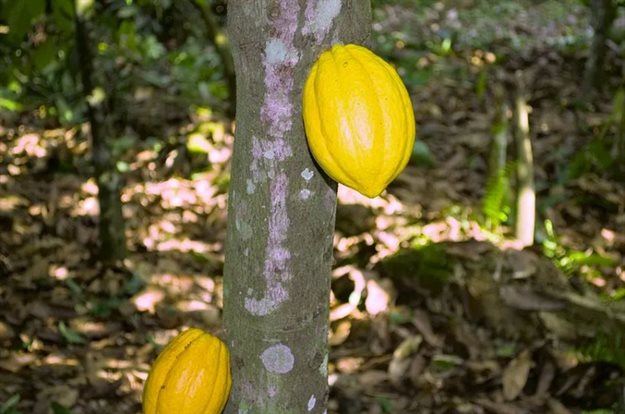Ghana's cocoa farmers are trapped by the chocolate industry

In research published last year I explored sustainability programmes designed to support cocoa farming in West Africa. My aim was to identify winners and losers.
I looked at initiatives such as CocoaAction, a $500m “sustainability scheme” launched in 2014, and concluded that they were done in the interests of large multinationals. They did not necessarily relieve poverty or develop the region’s economies. In fact they created new problems.
To sustain their livelihoods, the cocoa farmers of Côte d’Ivoire and Ghana need to diversify away from cocoa production. But multinational chocolate companies need farmers to keep producing cocoa.
Diversification
Farmers choose to diversify their crops for a host of reasons. These include a reduction in the resources they need to produce a crop (such as suitable land), and a reduction in the price they can get for the crop.
Cocoa farming requires tropical forestland. This is limited; it is not possible to keep expanding to new land to keep producing cocoa. So when the land is exhausted, farmers would benefit from diversifying to products like rubber and palm oil. They do not need to grow cocoa for its own sake.
A great deal of diversification occurred during the cocoa crisis of the 1970s in Ghana. Cereal output increased from 388,000 tonnes in 1964/1965 to over 1 million tonnes in 1983/83, and decreased when cocoa was “revitalised”. The same was the case with coconut, palm oil and groundnut.
But such diversification is more recently being prevented by multinationals and other stakeholders who want cocoa cultivation to continue. Multinationals that depend on cocoa as a raw material openly (and rightly) regard diversification as a risk to their business. So they keep spending on cocoa farming inputs.
Why there’s a limit to cocoa
In West Africa, cocoa has historically been cultivated using slash and burn farming. Forest was cut down and burned before planting, and then, when the plot became infertile, the farmer moved to fresh forestland and did the same again.
The new land offered fertile soil, a favourable microclimate and fewer pests and diseases. Growing the cocoa took less labour and yielded more.
This explains the link between cocoa farming and deforestation in Côte d'Ivoire and Ghana. A recent investigation showed that since 2000, Ivorian cocoa has been dependent on protected areas. Almost half of Mont Peko National Park, for example, which is home to endangered species, as well as Marahoue National Park has been lost to cocoa planting since 2000.
In Côte d’Ivoire, the area covered by forest decreased from 16 million hectares – roughly half of the country – in 1960 to less than 2 million hectares in 2005.
Forestland is finite. Slash and burn is no longer an option, because so much of the forest is gone. In West Africa, planters are now staying on the same piece of land and reworking it.
This has created its own set of problems.
Rising costs and threats
In both Ghana and Côte d’Ivoire, several estimates of the cost of maintaining a cocoa farm show that the investment costs required for replanting have approximately doubled. One estimate of labour investment put the replanting effort at 260 days per hectare, compared with 74 days per hectare for planting using slash and burn.
The extra labour needed for sedentary cultivation is leading to child trafficking and child labour in cocoa cultivation. Child trafficking generally occurs when planters are searching for cheaper sources of labour for replanting.
Planters who have successfully diversified into other crops have stopped using child labour. In the cocoa industry, however, the use of child labour is increasing. For example, the number of child labourers in the Ivorian cocoa industry increased by almost 400,000 between 2008 and 2013.
There has also been a massive increase in the use of fertilisers and pesticides to aid cocoa production without slash and burn.
The increased input (labour, fertilisers and pesticides) for replanting land amounts to a higher production cost. It cannot be adjusted by price setting. Cocoa producers have no control over price; they are price takers. So the higher production cost reduces the profit made by cocoa farmers.
This explains why cocoa producers in Côte d’Ivoire are poorer now than they were decades ago.
In Ghana, the government, through the cocoa marketing board, COCOBOD, has managed the transition from slash and burn to sedentary farming. The government created a mass spraying programme to control diseases and pests. It also subsidised fertiliser and created a pricing policy that has sometimes amounted to a government subsidy this links need users to subscribe. Due to the extra free input provided by the government, sometimes supported by NGOs and multinational corporations, farmers have not become poorer in Ghana. But the approach has led to huge debt for COCOBOD. For example, COCOBOD incurred GHc2 billion ($367m) debt for subsidising the price of cocoa for the year 2017.
Although cocoa planters are faring well in Ghana, it is not clear that Ghana’s cocoa sector is really a success story. The shift to debt financing has artificially produced the success.
The way forward
Cocoa “sustainability” activities are not the way forward. Cocoa sustainability is a new form of colonisation in Africa, because its real goal is to prevent African planters from diversifying away from cocoa into other crops. These programmes keep the cocoa industry going under deteriorating conditions.
The way forward is to switch from cocoa to crops that do not require forestland (new or exhausted), extra fertilisers or more labour.
Research has shown that cocoa planters in Côte d’Ivoire who have diversified into other crops, such as rubber, have succeeded in escaping poverty.
But that is seen as a major threat to the supply of raw material to Western multinationals. One representative of a large chocolate multinational explained “my enemy is not my competitor in the purchase of cocoa, but the rubber industry.”
In conclusion, Ghana and Côte d’Ivoire have to think about what is best for them instead of what is best for the chocolate industry and consumers in the developed world.
This article is republished from The Conversation under a Creative Commons license. Read the original article.![]()
Source: The Conversation Africa

The Conversation Africa is an independent source of news and views from the academic and research community. Its aim is to promote better understanding of current affairs and complex issues, and allow for a better quality of public discourse and conversation.
Go to: https://theconversation.com/africaAbout Michael E Odijie
Michael E Odijie, post doctoral researcher, University of CambridgeRelated
Ivory Coast signals cocoa price hike in response to US tariffs 11 Apr 2025 Drought, heat pose a double threat to Ivory Coast cocoa farmers 17 Dec 2024 Ghana expects recovery in cocoa production for 2024/25 season 7 Nov 2024 Ghana to raise cocoa farmgate price by nearly 45% 3 Sep 2024 Cocoa traders suffer $1bn blow amid Ghana supply issues 15 Jul 2024 Cocoa farmers optimistic as soil moisture aids growth in Ivory Coast 9 Jul 2024























